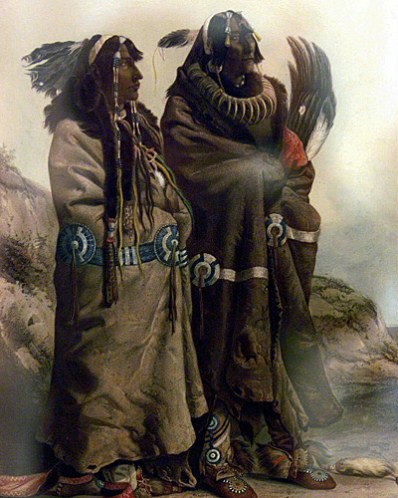
Susquehannock Native Americans.
The Susquehannock people, also called the Conestoga (by the English) were Iroquoian-speaking Native Americans who lived in areas adjacent to the Susquehanna River and its tributaries from its upper reaches in the southern part of what is now New York (and the lands of the Five Nations of the Iroquois Confederacy), through East-central and central Pennsylvania (West of the Poconos and the Delaware nations), with lands extending beyond the mouth of the Susquehanna in Maryland along the west bank of the Potomac at the north end of the Chesapeake Bay. Evidence of their habitation has also been found in West Virginia. The Cumberland Narrows pass, later called the Nemacolin Trail, abutted their range and it was likely navigable through valleys from their large settlement at Conestoga, Pennsylvania
.The original population of the Susquehannock is uncertain due to lack of contact with the Europeans, whose records provide such data. The Europeans' best guesses are that the tribe numbered from 5000-7000 in 1600, and were a regional power capable of holding off the Iroquois Confederacy early in the century when the Iroquois began warfare in pursuit of fur trading.The Susquehannock later effectively defeated the Seneca nation and Cayuga nation of the Iroquois in mid-century circa 1666. They may have decimated bands of the Delaware, who became a tributary nation following a war with the fierce Susquehannock before 1640. In the later case, and through the balance of the century, the Susquehannock were allied with the Swedes, who traded them firearms for furs as early as the 1610s. The nation also fought a war declared by the Province of Maryland from 1642-50s and won it, albeit with help from their long-time allies the Swedes.
But following the zenith of their tribal power in the 1670s, the Susquehannock suffered an extremely rapid decline— presumably from infectious diseases such as smallpox, which also decimated the Mohawk and other Iroquois, as well as other Native American groups.Weakened by their losses, they were overcome by the balance of the Iroquois. Their numbers may have diminished to about 300 in 1700.
The Susquehannock society was a confederacy of up to 20 smaller tribes, who occupied scattered villages along the Susquehanna River. The Susquehannock nation remained independent and not part of any confederacy into the 1600s. Ultimately, they were not strong enough to withstand the competition from colonists and other tribes in their piece of the so-called Beaver Wars of that century. About 1677 their remaining people, decimated by disease and war, merged with their former enemies and distant language kin, the Haudenosaunee (Iroquois) Five Nations, based in New York.
Around 1677, most of the remaining Susquehannock moved to New York, joining mostly with the Seneca and Onondaga nations, who also spoke Iroquoian languages. The Iroquois, who had a longer tradition of adopting defeated enemies into their tribe, and Governor Edmund Andros of the Province of New York told the Susquehannock they would be welcome in New York and protected from Maryland and Virginia. Some returned to their homeland on the southern, shores of the Susquehanna River, keeping their distance from the center of Iroquois power. Others moved to the upper Delaware River into the somewhat depopulated Delaware Nation lands (ravaged both by the Susquehannock who had made them tributary and the Iroquois, which had competed with the Algonquian-speaking peoples), where they lived under the protection of New York.
The remnants of the Susquehannock lived under the protection of the provincial Pennsylvania government, but their population declined steadily. In 1763, a census counted twenty-two people in Conestoga Town. That year the Paxton Boys, in response to Pontiac's Rebellion on the western frontier, attacked the village, killing six people. The remaining Indians were sheltered in a Lancaster workhouse by the Commonwealth. The governor discouraged further violence, but two weeks later, the Paxton Boys killed the 14 Susquehannock at the workhouse. www.wikipedia.com
MULUC
Kin 89: Red Spectral Moon
I dissolve in order to purify
Releasing flow
I seal the process of universal water
With the spectral flow of liberation
I am guided by my own power doubled.
In order to understand your own mind, you must become skilled at critical thinking and exercising the power of discrimination.*
*Star Traveler's 13 Moon Almanac of Synchronicity, Galactic Research Institute, Law of Time Press, Ashland, Oregon, 2015 - 2016.
The Sacred Tzolk'in
Visshudha Chakra (Alpha Plasma)





No comments:
Post a Comment